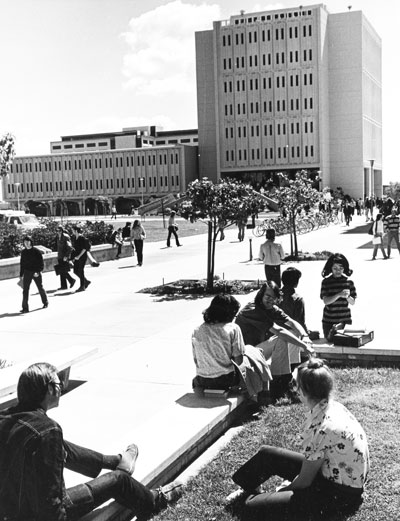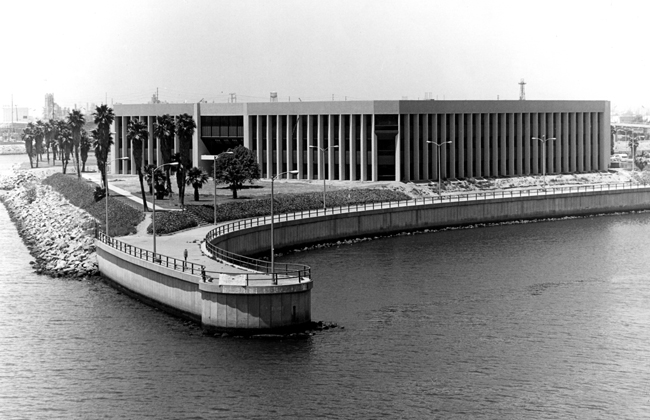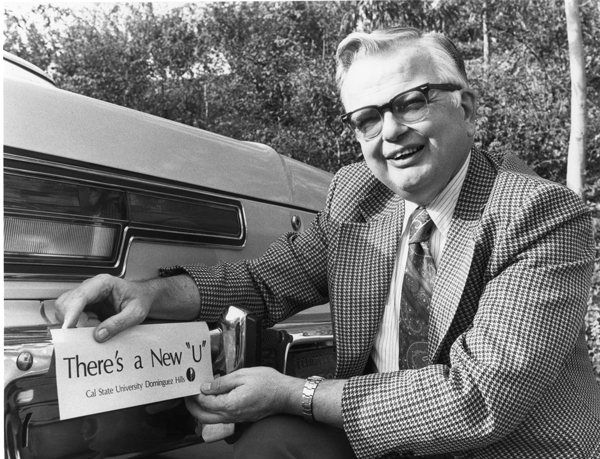The individual California State Colleges were brought together as a system by the Donahoe Higher Education Act of 1960. In 1972, the system became The California State University and Colleges and in 1982, the system became The California State University. Today, the campuses of the CSU include comprehensive and polytechnic universities and, since July 1995, the California State University Maritime Academy, a specialized campus.
The oldest campus, San José State University, was founded in 1857 and became the first institution of public higher education in California. The newest campus, California State University, Channel Islands, opened in fall 2002, with freshmen arriving in fall 2003.

Historic Milestones
1857-71 - Weekly Normal School, a training school for elementary teachers, established by San Francisco Board of Education. It becomes the California State Normal School in 1862, the first institution of higher education established by the state. Under the jurisdiction of the State Board of Education, the institution was moved to San José in 1871 and today is San José State University.
1887-99 - State Normal Schools are established at Chico (1887), San Diego (1897) and San Francisco (1899).
1901 - California Polytechnic School is established at San Luis Obispo.
1911-13 - State Normal School is established at Fresno (1911) and Humboldt (1913).
1921 - “Normal Schools” become “Teachers Colleges.”
1923 - Teachers Colleges are authorized to confer B.A. degrees in education.
1935 - “Teachers Colleges” become “State Colleges.”
1938 - California State Polytechnic School establishes a southern campus at San Dimas.
1946 - Graduate instruction is offered in the form of a fifth year of study leading to the secondary teaching credential.
1947-49 - Campuses are established at Los Angeles (1947), Sacramento (1947) and Long Beach (1949).
1949 - M.A. degrees in teacher education are offered in conjunction with a teaching credential.
1955 - M.S. degrees in vocational fields are authorized.
1957-60 - Campuses are authorized at Fullerton (1957), Hayward (1957), Stanislaus (1957), San Fernando Valley (1958), Sonoma (1960), San Bernardino (1960) and Dominguez Hills (1960).
The recommendations that laid the groundwork for the California State Colleges (CSC), which would ultimately become the California State University.
1961 - The “California State Colleges” (CSC) is established as a system with a Board of Trustees and a chancellor by the Donahoe Higher Education Act of 1960, which followed the recommendations of “A Master Plan for Higher Education in California, 1960-1975.” The Donahoe Act assigns different functions to the University of California, the California State Colleges and the California Community Colleges. The primary function of the State Colleges is broadened to include undergraduate and graduate instruction in the liberal arts and sciences, in applied fields and in the professions; doctoral degrees are authorized if offered jointly with the University of California.
1962 - Campus Physical Master Plans are coordinated systemwide by Trustees; architectural planning emphasizes educational functions of buildings, reasonable costs and aesthetic considerations.
1962 - The CSC Foundation is created to promote and assist education, administration and related services of the CSC, the trustees and the chancellor.
1963 - The Statewide Academic Senate is established to represent State College faculties.
1963 - The Board of Trustees approves a “Master Curricular Plan,” which reaffirms that the State Colleges, as multipurpose institutions, provide preparation for professional and occupational goals as well as broad liberal education and recognizes that “all colleges cannot be all things to all people.”
1963 - International Programs are established by the Board of Trustees as a statewide academic unit to offer students study-abroad opportunities at distinguished universities throughout the world.
1964 - The first annual five-year Academic Master Plans is designed to project future degree programs developed by each college and approved by the Board of Trustees. Two-year professional master’s degrees (e.g., M.S.W.) are offered by several colleges.
1965 - California State College, Bakersfield is authorized.
1966 - California State Polytechnic College’s southern campus at Pomona becomes independent.
1968 - A systemwide computer network is established to connect 19 campuses to a central data center at the Chancellor’s Office.
1970 - A common admissions program is implemented to govern all applications, beginning fall 1971.
1971 - A statewide Alumni Council is organized.
1971 - The first undergraduate and graduate external degree pilot programs are implemented to serve populations not previously reached.
1972 - The State Colleges system is designated “The California State University and Colleges.” Having met criteria established by the Board of Trustees and the Coordinating Council for Higher Education, 14 campuses are designated universities; five campuses remain colleges. The roster:

Down time between classes.
- California State College, Bakersfield
- California State University, Chico
- California State College, Dominguez Hills
- California State University, Fresno
- California State University, Fullerton
- California State University, Hayward
- California State University, Humboldt
- California State University, Long Beach
- California State University, Los Angeles
- California State University, Northridge (formerly San Fernando Valley)
- California State Polytechnic University, Pomona
- California State University, Sacramento
- California State College, San Bernardino
- California State University, San Diego
- California State University, San Francisco
- California State University, San José
- California Polytechnic State University, San Luis Obispo
- California State College, Sonoma
- California State College, Stanislaus
1973 - The Consortium of The California State University and Colleges is established. The Consortium, or “1,000-Mile Campus,” draws upon the resources of the campuses to offer regional and statewide undergraduate (upper-division) and graduate external degree and certificate programs to adult Californians who find it difficult to attend on-campus classes.
1974-76 - In 1974, Senate Bill 381 changes the names of four campuses to Humboldt State University, San Diego State University, San Francisco State University and San José State University. In 1976, Assembly Bill 3063 renames California State College, Sonoma to Sonoma State College.
1976 - A Student Trustee position is created on the Board of Trustees and a first member is named to a two-year term. Nominations are made to the governor by the CSUC Student Presidents Association.
1976 - Construction is completed and the first permanent headquarters building of the CSU is occupied in Long Beach. Previously, system offices had been in leased space in Inglewood (1961-65) and then in Los Angeles.

The first permanent headquarters building of the CSU, located in Long Beach.
1977 - An Alumni Trustee position is created, and a first member is named to a two-year term. The member is selected by the Statewide Alumni Council.
1977-78 - University status is attained by California State College, Dominguez Hills (1974) and Sonoma State University (1978).
1978 - Trustees authorize the first joint doctoral program between a CSUC campus and a private university, a Ph.D. in education at San Diego State University and Claremont Graduate School.
1979 - The 1978 Higher Education Employer-Employee Relations Act (HEERA) takes effect, authorizing CSU employees to participate in collective bargaining.
1982 - The State University and Colleges system is designated “The California State University” (CSU).
1983 - A Faculty Trustee position is created, and the first member is named to a two-year term. The governor appoints the member from a list provided by the CSU Academic Senate.
1984 - Incoming freshmen and transfer students are now required by the CSU Board of Trustees to meet basic admissions requirements of college preparatory English (four years) and math (two years).
1984-87 - University status is attained by California State College, San Bernardino (1984), California State College, Stanislaus (1985) and California State College, Bakersfield (1987).
1988 - Incoming freshmen and transfer students are now required by the CSU Board of Trustees to meet expanded admissions requirements: four years of college preparatory English, three years of college preparatory math, one year of a laboratory science, two years of a foreign language, one year of U.S. history/government, one year of visual/performing arts and three years of electives.
1988-89 - The 20th campus is created at San Marcos, and a founding president is named.

The Dominguez Hills campus attained university status in 1974.
1995 - California Maritime Academy, founded in 1929, joins the CSU system.
1995 - California State University, Monterey Bay, a redevelopment of former military base Fort Ord, admits its first students.
1998 - Trustees accept former Camarillo State Hospital as the future site of California State University Channel Islands; students at the Ventura off-campus center begin classes at the site in fall 1999.
2000 - A second Student Trustee position is created. Student Trustees serve staggered, two-year terms and have voting rights only in the second year.
2000 - Trustees approve aligning course requirements with the University of California so students can qualify for admission to either by taking the same set of courses.
2003 - California State University Channel Islands begins accepting freshmen at the new campus.
2005 - California State University, Hayward is renamed California State University, East Bay.
2010 - The California State University celebrates its 50th anniversary.
2013 - Cal State Online, a systemwide collection of services that support the delivery of fully online programs at campuses, launches its first degree completion program. The program, in business administration, is taught and administered by faculty at Cal State Fullerton.
2013 - The Cal State Concurrent Enrollment Program debuts. This intrasystem concurrent enrollment program will provide full-time students enrolled at any campus access to fully online courses offered at other CSU campuses.
2014 - The CSU STEM VISTA Program launches to increase the number of students, especially from underrepresented communities, graduating with STEM (science, technology, engineering and mathematics) degrees.
2014 - The California State University surpasses 3 million living alumni, marking the milestone with the “Class of 3 Million” celebration. In addition, the number of degrees conferred annually surpasses 100,000.
2016 - The CSU Board of Trustees approves the systemwide Graduation Initiative 2025 to increase graduation rates and eliminate the achievement gap by reducing students’ barriers to completing their degrees.
2018 - For the first time in the CSU’s history, a majority of the campus presidents are female, with 12 of the 23 campuses being led by women.

The 12 women presidents of the CSU in 2018.
2020 - Amid the COVID-19 pandemic, the university successfully transitioned all 23 campuses to virtual instruction for the health and safety of its faculty, staff and students.
2020 - The CSU Center to Close the Opportunity Gap: Identifying Best Practices to Ensure Student Achievement in California’s K-12 Schools opened at California State University, Long Beach to eliminate equity gaps at all levels of education.